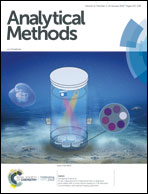Stable and reproducible nano-electrospray ionization of aqueous solutions and untreated biological samples using ion current limitation combined with polarity reversing†
Abstract
Owing to its high chemical sensitivity and low sample consumption, nanoelectrospray ionization mass spectrometry (nESI-MS) is nowadays widely used in various fields such as chemistry, biology, medicine, pharmaceutical industry, clinical assessment and forensic science. The key analytical limitations of conventional nESI-MS analysis include low stability and poor tip-to-tip reproducibility of analyte signals due to the common clogging of glass capillary tips and the occurrence of electric discharge, especially for the analysis of aqueous solutions. In this study, the nESI current was greatly reduced and the corona discharge was efficiently quenched using a 10 GΩ resistor placed in series between a pulled glass capillary and a high voltage power supply. Additionally, polarity reversing was applied for the in situ salt removal and higher signal intensity than in conventional nESI. Furthermore, by closing the back side of the pulled glass capillary during the analysis the sample flow rate could be reduced down to ca. 1 nL min−1. This combined approach allows the analysis of various aqueous solutions and untreated biological samples without tip clogging and electric discharge both in positive and negative modes with enhanced chemical sensitivity, high signal durability (up to several hours per sample) and excellent tip-to-tip reproducibility (80–90%). We believe that the proposed approach may solve many current problems and significantly advance nESI mass spectrometry in the very near future.



 Please wait while we load your content...
Please wait while we load your content...